Col. Sudhir Farm
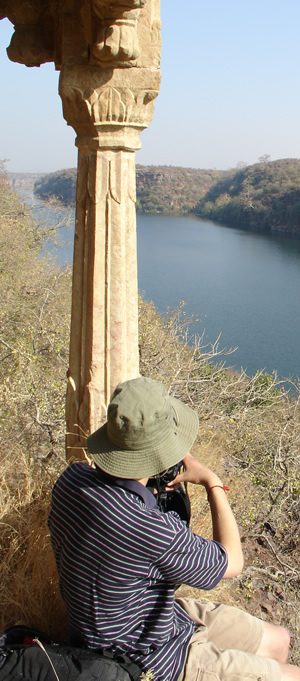
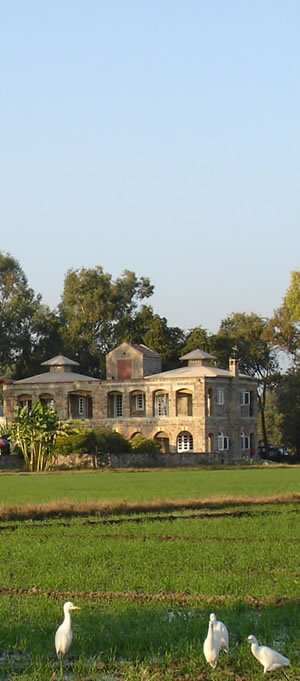
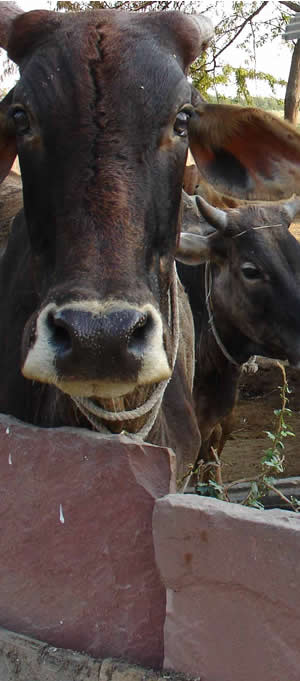
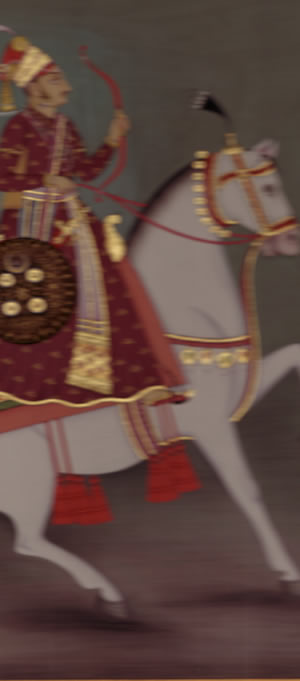
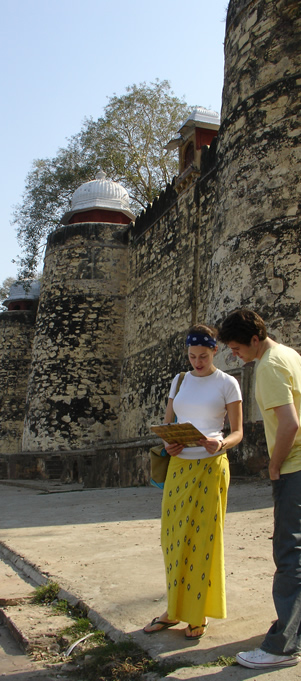
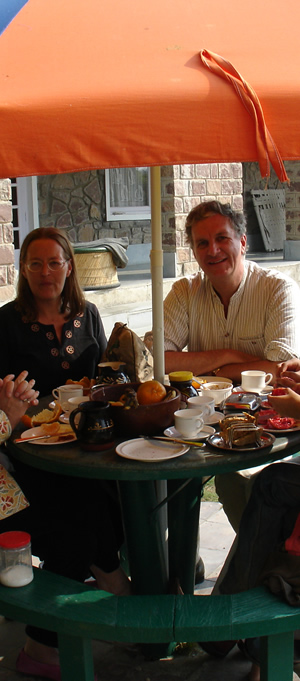
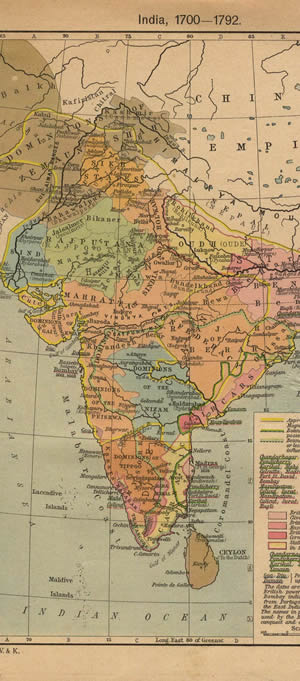
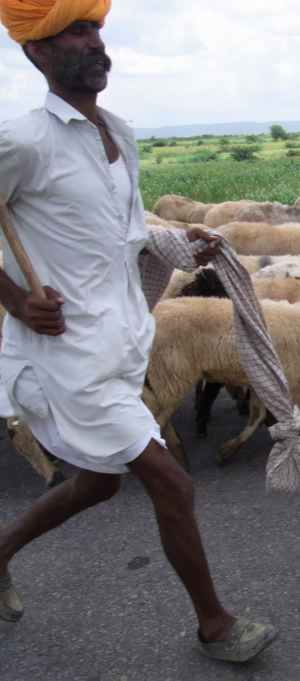
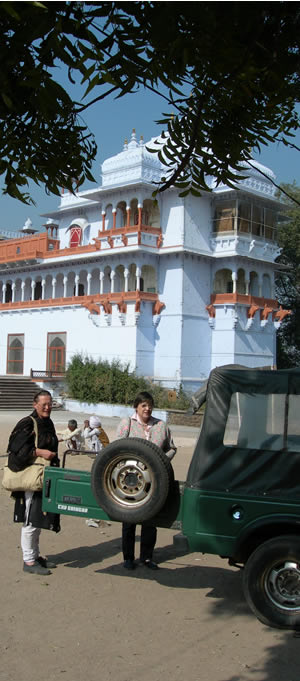
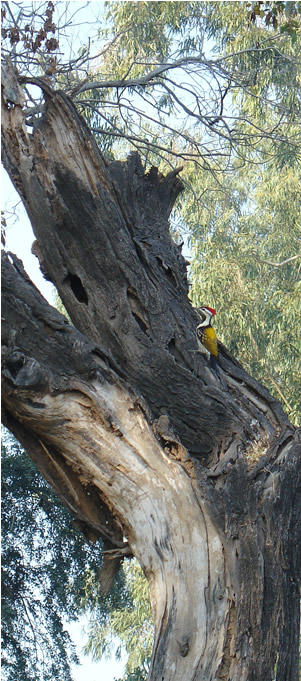
Snippets from the Visitors' Book
The Kota tonga trail was a real highlight - a bit like a 19th Century treasure hunt. It’s full of little nuggets of unusual information and fascinating glimpses into the unsolved mysteries of Kota.
Harriet and Will, London. UK
The memorial to Major Burton and his sons was much more moving than the Taj Mahal or the lake at Udaipur, marvellous as they are.
Henry Vane, Cumbria, UK
...the most comfortable bed I’ve slept in for 2 months....
Charlotte Adam, Winchester UK
Two days out of the noise and the people in a beautiful place. We felt totally
at home
- To be recommended to every person who wishes to experience the Indian country life. We also liked the way the food was prepared...
Patrick & Marie-Christine Lemaigre, Nil-St Vincent, Belgium
We’re only here for the porridge and home made bread! Thank you for a most wonderful time the memories of which we shall carry always. You have given us a wonderful & fascinating introduction to India.
Sue Turner, Lancashire, UK
So ...Rajasthan is not all desert! Thank you for sharing everything with us....
The Read family, London, UK
What a wonderful time we’ve had at the school in the village, at the weavers’, on the river, atop a tonga! Thank you for all your help and contacts throughout India
Anne Gerbner, Philadelphia, USA
It was a wonderful stay and thank you for giving us such a positive look at India and Rajasthan.
Salma Goldstein, New Jersey, USA
- There once was a lady of Kota
- Who took visitors out in her motor
- With the roads and the ruts
- It took quite some guts
- To go out with the lady of Kota.
- But once back at home on the farm
- The world quite descended to calm
- With the plants and the birds
- And fox terriers in herds
- There was balm in the calm on the farm.
Sue Millar, London, UK
After travelling around Rajasthan for two weeks, reaching a real house with books on the shelves, photos on the walls and four happy dogs was simply wonderful.
Camille Savinien, Paris, France
This isn’t tourism. I know of nowhere else where you can experience the real India as well as on your traditional working Rajasthani farm.
Sam Milward, Wellington, New Zealand
Thank you so very much for such a wonderful stay - what a fantastic introduction to India. I don’t think we’ll find such tranquillity elsewhere.
Lizzie Fortune, Hampshire. UK
Fabulous - I’ve been spoilt. It’s hard to leave and face the real world.
Elisabeth Simson, Isle of Wight, UK
After travelling around Rajasthan for two weeks, reaching a real house with books on the shelves, photos on the walls and four happy dogs was simply wonderful.
Camille Savinien, Paris, France
This isn’t tourism. I know of nowhere else where you can experience the real India as well as on your traditional working Rajasthani farm.
Sam Milward, Wellington, New Zealand
Thank you so very much for such a wonderful stay - what a fantastic introduction to India. I don’t think we’ll find such tranquillity elsewhere.
Lizzie Fortune, Hampshire. UK
Our visit at the farm was truly wonderful, off the beaten track it is a slice of India a visitor does not normally experience. Victoria is very knowledgeable about Indian culture and the people - an added perspective for us. The food here was very delicious: organically home grown ingredients, vegetables, fruits, grains prepared simply homestyle. A nice change from curries. Enjoyed the early morning boat ride and walk to the weavers. Many thanks.
Johanna Janssens, Washington, USA
I loved staying with you and the dogs and playing with the toys.
Jonas aged 8, Switzerland
A very welcome break from the crazy world of India – wonderful house, food and hospitality. Thank you so much.
Katie Buxton, Bath, UK
I loved seeing the crocodiles, and I learned a lot about deticking the puppies. Coming to the farm was a great experience.
Stella Bartholet, Washington, USA
A wonderful eye opening visit in every sense. We will be back! Thank you!
Christopher & Joanna Hobson, Northamptonshire, UK
A blissfully peaceful stay. We enjoyed everything – even the power cut. Thank you for lovely food, good company and very interesting trips.
Vicky Stark, London, UK
Exactly what we hoped for and more, bits of India off the tourist track, life as it actually is in villages, teeming life and livestock and the magic of the river.
Sir Hilary Miller, Worcester, UK
Thank you for the introduction to miniature painters, wall paintings, stories, great food, good company, walk through the fields. I loved the paintings in the City Palace and go back full of inspiration and memories.
Nan Mulder, Edinburgh, UK

On the Farm - 2018 Archive
On the Farm - December ’18
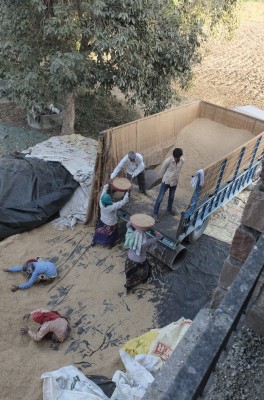 The main aim in December was to sell the rice but the queues were so long to get into the mandi, where the rice is dumped in piles and then sold and bagged, that the tractors turned back. It was said that the price at the Kota mandi was higher than in Madhya Pradesh, our next door state, and so traders were buying up rice from the farmers at the lower price and reselling it in Kota thereby leading to the large queues which affected the local farmers.
The main aim in December was to sell the rice but the queues were so long to get into the mandi, where the rice is dumped in piles and then sold and bagged, that the tractors turned back. It was said that the price at the Kota mandi was higher than in Madhya Pradesh, our next door state, and so traders were buying up rice from the farmers at the lower price and reselling it in Kota thereby leading to the large queues which affected the local farmers.
We waited until after the state elections on 7th December before trying again and were relieved to find that the price had gone up and not down. Some of our rice had been waiting under black tarpauline for a month before being sold.
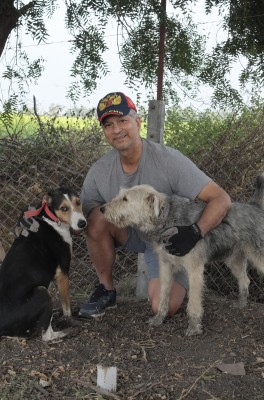 The gaps in the nilgai fence were finally closed off this month. The builders of the wall had left gaps at the drainage gullies and animals had been coming and going through them.
The gaps in the nilgai fence were finally closed off this month. The builders of the wall had left gaps at the drainage gullies and animals had been coming and going through them.
Here is Vijay by the fence with Lucy and Tigger who like to be present when work is going on. They still have work to do at night warning visiting pigs and nilgai but with all land covered in young wheat the wildlife spreads out.
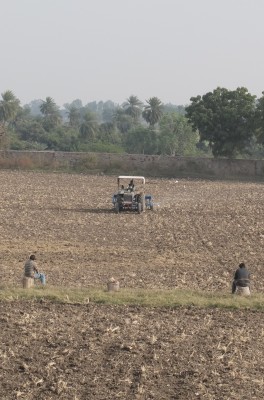 The rice fields had to be watered and prepared for wheat sowing. By the 17th we had planted in all fields that had previously had rice.
The rice fields had to be watered and prepared for wheat sowing. By the 17th we had planted in all fields that had previously had rice.
Two calves were born this month. The mother of one prolapsed which was a medical emergency and the vet came and stitched her up and mother and baby Rani are now fine. The second cow is a bad mother and has a history of kicking her calves or ignoring them. A male calf was born to her on a cold night on 22nd and struggled to stand. Despite our best efforts he died 24 hours later. December was cooler than usual and the potatoes were damaged by air frost. Log fires were a treat in the evenings and Christmas felt a bit Christmasy with night temperatures of 5oC.
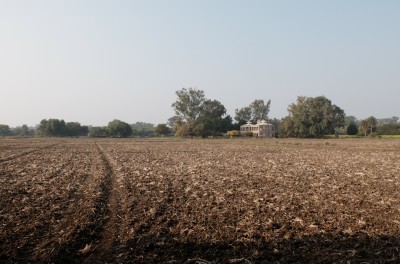 This is the farm landscape after the wheat had been planted but before it had sprouted. The mustard is still flowering and within a month this view will be transformed by an expanse of green.
This is the farm landscape after the wheat had been planted but before it had sprouted. The mustard is still flowering and within a month this view will be transformed by an expanse of green.
Happy New Year
On the Farm - November ’18
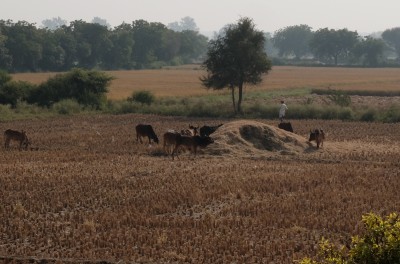 Although the rice was threshed at the beginning of the month it could not be sold as there was such a flood of rice at the market that the tractors and trollies were queuing for half a kilometre to get into the grain market gates to dump their loads. Ghasilal managed to sell his first trolley load but brought the second back as he did not want to wait in a queue all night. Sporadically, the mandi/market had been closed for a day to give them time to clear the backlog. We are waiting for the rush to ease but hope the price will stay up even after the Rajasthan state elections on 7th December.
Although the rice was threshed at the beginning of the month it could not be sold as there was such a flood of rice at the market that the tractors and trollies were queuing for half a kilometre to get into the grain market gates to dump their loads. Ghasilal managed to sell his first trolley load but brought the second back as he did not want to wait in a queue all night. Sporadically, the mandi/market had been closed for a day to give them time to clear the backlog. We are waiting for the rush to ease but hope the price will stay up even after the Rajasthan state elections on 7th December.
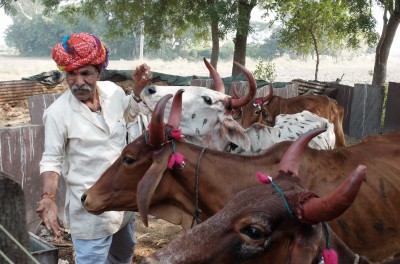 Diwali was on 7th November and as usual we honoured the cows on the second day with Govardhan puja. The cows were washed and linseed oil and henna put on their horns. They were fed sweetened puris, which they love. Most of the cows actively participate, but Lasho, the bull, will have nothing to do with it.
Diwali was on 7th November and as usual we honoured the cows on the second day with Govardhan puja. The cows were washed and linseed oil and henna put on their horns. They were fed sweetened puris, which they love. Most of the cows actively participate, but Lasho, the bull, will have nothing to do with it.
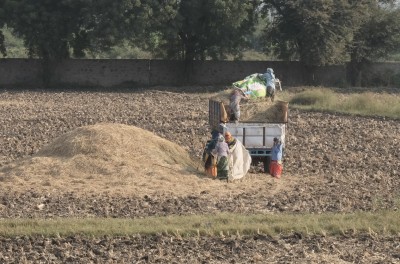
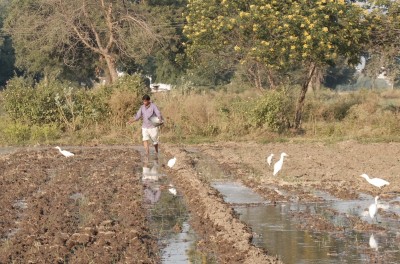
The cows had been enjoying eating the rice straw or pral in the fields and it was fed to them in their enclosure. On the 21st four women came to load the trollies with pral and dump it near the cowshed. It took them six days to clear the fields of the rice straw. When it is ready, the milking cows will be fed green fodder like alfalfa called bersin every day. Bersin is broadcast and then watered. This was done right after Diwali.
Our former hali (farm worker), Vinod, was finally married on the 19th near Kanpur in Uttar Pradesh. He has been let down at least twice before. He brought his wife to meet us. His wife, Arti, claims to be 18 years old, but looks younger. She is a slip of a girl compared to Vinod who is twice her size and weight. It is illegal for a bride to be under 18 and the groom to be under 21. But she is from the same community as Vinod and we hope they will be very happy.
On the Farm - October ’18
We achieved a lot in October and now have a chain link fence not only around the vegetables but along the border with the road. The chain link fence is made locally and looks like this when delivered. The concrete posts were made near Tonk 150 kms to the north and delivered by tractor-trolley. The team of four young men who erected it were local and charged Rs.100 per post, that’s about GBP 1.10 to hand dig each post hole and erect the fence. They did 91 posts in two days.
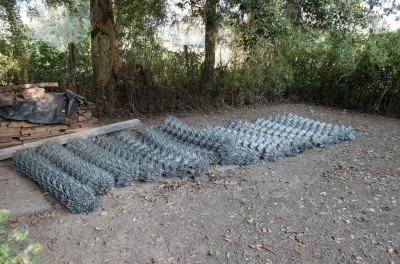
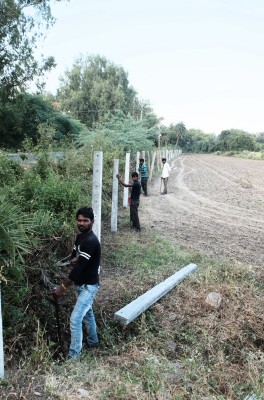
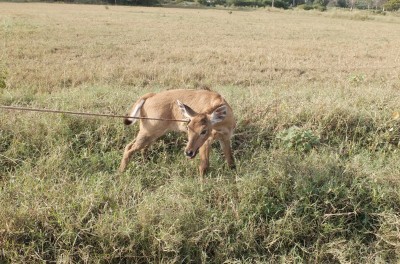 On 16th October a young nilgai was caught on the farm and then released. This is the dilemma that it will grow up and add to the size of the herd destroying our crops. On the 10th four wild boar were found dead on the road killed by a single vehicle. A large herd must have been exiting our farm.
On 16th October a young nilgai was caught on the farm and then released. This is the dilemma that it will grow up and add to the size of the herd destroying our crops. On the 10th four wild boar were found dead on the road killed by a single vehicle. A large herd must have been exiting our farm.
We watered the fields after the monsoon and sowed DuPont Pioneer mustard seeds as we did last year. We searched for an Indian hybrid seed but couldn’t find one. At Rs. 510/kg it is five times the price of local seed.
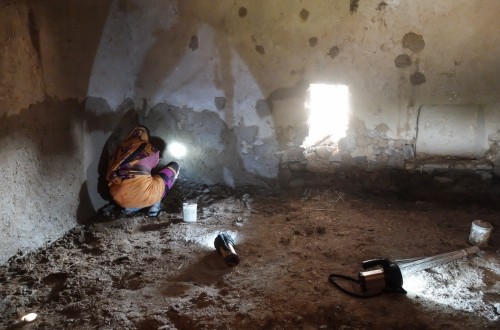 This month we rebuilt one part of the cow shed with stones and mud as it had partly collapsed in the monsoon. Two women worked for five days re-plastering it with a soil, chaff and cow dung mixture. They did the inside where the chaff is stored by torch light.
This month we rebuilt one part of the cow shed with stones and mud as it had partly collapsed in the monsoon. Two women worked for five days re-plastering it with a soil, chaff and cow dung mixture. They did the inside where the chaff is stored by torch light.
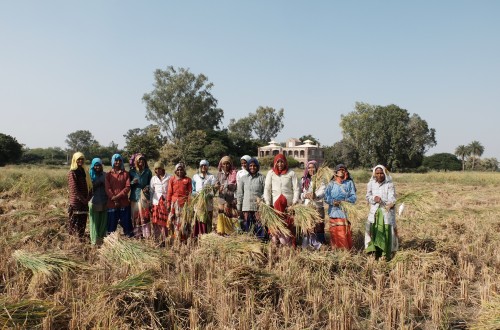 By the end of October the first rice was ready to be harvested. This year we didn’t use a combine harvester which is quick and efficient but cuts the rice close to the grain and leaves the straw all over the field. This team of 14 women hand cut the rice close to the ground and laid it in bundles to dry, but didn’t have to tie the bundles and beat them against an empty oil barrel before feeding through a thresher as used to happen. Instead, they gathered the bundles into piles on a large tarpaulin to catch any loose grain and then threshed in a single process which left the rice straw in enormous piles, so the stubble does not have to be burnt adding to air pollution. It seems like a good compromise but there is still the problem that the recommended way to prevent rice blast is to burn the stubble.
By the end of October the first rice was ready to be harvested. This year we didn’t use a combine harvester which is quick and efficient but cuts the rice close to the grain and leaves the straw all over the field. This team of 14 women hand cut the rice close to the ground and laid it in bundles to dry, but didn’t have to tie the bundles and beat them against an empty oil barrel before feeding through a thresher as used to happen. Instead, they gathered the bundles into piles on a large tarpaulin to catch any loose grain and then threshed in a single process which left the rice straw in enormous piles, so the stubble does not have to be burnt adding to air pollution. It seems like a good compromise but there is still the problem that the recommended way to prevent rice blast is to burn the stubble.
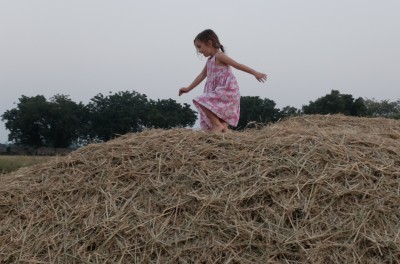 And to end the month, we had a long awaited visit from our son and four year old grand-daughter who took every opportunity to relish farm life.
And to end the month, we had a long awaited visit from our son and four year old grand-daughter who took every opportunity to relish farm life.
On the Farm - September ’18
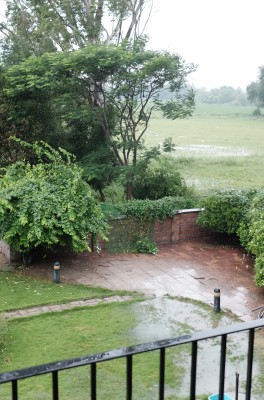 September is often a very hot and humid month, but this year there was drizzle and cooler temperatures prevailed. Ten centimetres of rain fell in six hours on 8th September, but overall there was little rain. The cooler weather, that is, under 30oC was blamed for a more serious infestation of rice blast which was attacking the base of the plants (?). The received wisdom seems to be to burn the stubble after the harvest to stop future occurrences, but on air-pollution grounds we are not supposed to do that. We did not spray our hand weeded rice but hope it will weather the blast on its own in healthy soil.
September is often a very hot and humid month, but this year there was drizzle and cooler temperatures prevailed. Ten centimetres of rain fell in six hours on 8th September, but overall there was little rain. The cooler weather, that is, under 30oC was blamed for a more serious infestation of rice blast which was attacking the base of the plants (?). The received wisdom seems to be to burn the stubble after the harvest to stop future occurrences, but on air-pollution grounds we are not supposed to do that. We did not spray our hand weeded rice but hope it will weather the blast on its own in healthy soil.
But Ghansi Lal, our share cropper, sprayed his rice for a first time with pesticide on the 17th. Four men walked through the rice holding a hose pipe which is powered by the tractor and sprays pesticide from a tractor-trailer mounted plastic tank. The tractor was parked close to the khejdi tree with the baya weaver bird nests. Thankfully, the birds did not abandon their nests, as they had done last year, because of the spraying.
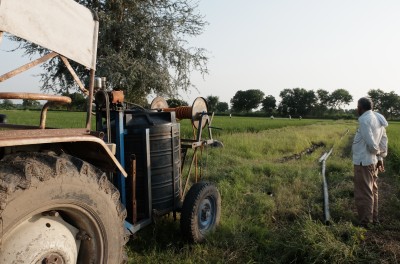
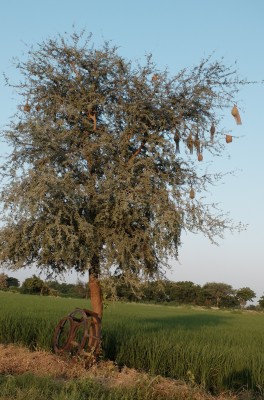
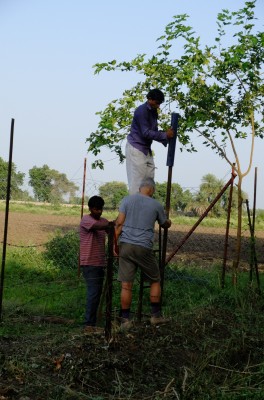 The nilgai proof chainlink fence was finished this month, but before it was completed a resourceful nilgai investigated for the weakest section and forced its way between the barbed wires. Monkeys are also getting bolder as Ghansi Lal complained that one had walked into his house, opened the fridge, and stolen the atta (dough). He is thinking of getting an airgun.
The nilgai proof chainlink fence was finished this month, but before it was completed a resourceful nilgai investigated for the weakest section and forced its way between the barbed wires. Monkeys are also getting bolder as Ghansi Lal complained that one had walked into his house, opened the fridge, and stolen the atta (dough). He is thinking of getting an airgun.
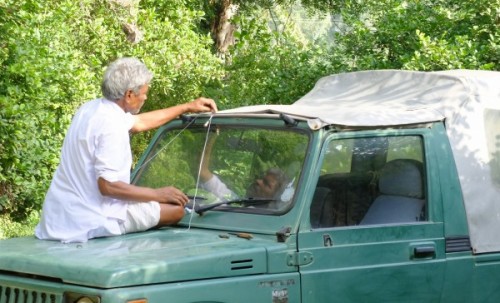 Because of the monsoon we were aware that the 4x4 Gypsy hood was leaking from stitches that had opened up. We were able to call Rodu to come and stitch it. He is the village mochi or leatherworker and used to skin dead cows and make some money from the hide. Now the Municipal Corporation has given the responsibility of removing dead animals on contract and so he misses out. He sits on the ground in the village and repairs shoes and stitches leather. He is always very clean and smartly dressed but is still expected to be grateful for crumbs from the upper castes. He never presumes to name a sum of money for his services to us and says Sahib will give as he thinks fit. For stitching this Gypsy hood he earned GBP 2.50, which was thought to be generous.
Because of the monsoon we were aware that the 4x4 Gypsy hood was leaking from stitches that had opened up. We were able to call Rodu to come and stitch it. He is the village mochi or leatherworker and used to skin dead cows and make some money from the hide. Now the Municipal Corporation has given the responsibility of removing dead animals on contract and so he misses out. He sits on the ground in the village and repairs shoes and stitches leather. He is always very clean and smartly dressed but is still expected to be grateful for crumbs from the upper castes. He never presumes to name a sum of money for his services to us and says Sahib will give as he thinks fit. For stitching this Gypsy hood he earned GBP 2.50, which was thought to be generous.
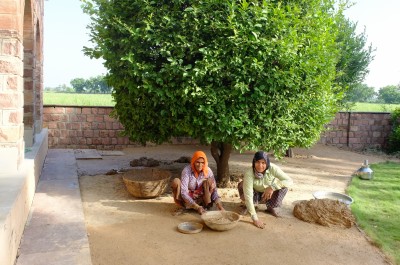 The two women who came to renew our leepner after the rains are used to daily wages. They were expecting GBP 2.50 a day for two days or Rs.400, and when I gave them Rs.500 each, the more confident named Dhankanwar (right), who has a son who owns a car but no income of her own unless she does agricultural labouring, was so overwhelmed that she touched my feet and said she would give a donation to a temple.
The two women who came to renew our leepner after the rains are used to daily wages. They were expecting GBP 2.50 a day for two days or Rs.400, and when I gave them Rs.500 each, the more confident named Dhankanwar (right), who has a son who owns a car but no income of her own unless she does agricultural labouring, was so overwhelmed that she touched my feet and said she would give a donation to a temple.
The standard of living for the three men who work on our farm has gone up this month as they now all have cooking gas connections and don’t have to rely on smokey bio-fuels. They will have to pay for the gas bottle refill, which currently costs about Rs.830, and so are inclined to use it sparingly.
Amarlal’s third child, a second daughter, was born in his wife’s village in Madhya Pradesh on 20th September. When his wife returns she will have a smoke free house to live and cook in. Under one of Prime Minister Modi’s schemes, poor women have been given gas connections in their names as a form of social empowerment and to cut back on the high rate of lung diseases caused by cooking with bio-fuels.
On the Farm - August ’18
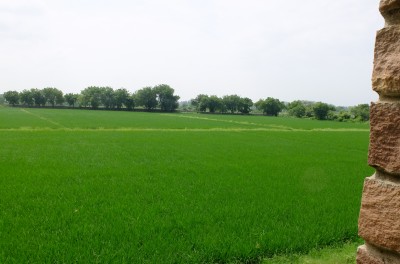 By the end of August the rice fields were green and healthy but the soyabean and dhaincha planted as green manure had been ploughed in.
By the end of August the rice fields were green and healthy but the soyabean and dhaincha planted as green manure had been ploughed in.
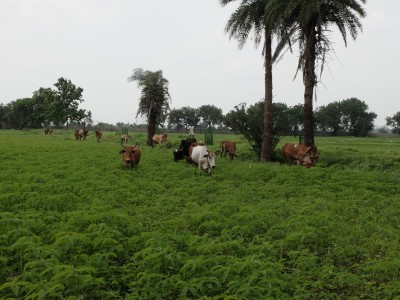 If this crop of dhaincha had been allowed to grow, it would have reached 6 feet and would have to have been cut by hand. Luckily, there was a dry-ish spell at the beginning of August so the tractor could plough.
If this crop of dhaincha had been allowed to grow, it would have reached 6 feet and would have to have been cut by hand. Luckily, there was a dry-ish spell at the beginning of August so the tractor could plough.
We had 31.6 cms. of rain in August, one quarter of which fell in 45 minutes on the 19th of August, so an average monsoon but no excess.
One main activity of the month was hand-weeding our 14 bighas of rice (6.5 bighas make one hectare). Upto 21 women a day worked for seven days to weed it. The rest of the rice fields were sprayed with a herbicide which luckily does not appear to have affected the weaver birds busily nest building on a khejdi tree in the rice fields.
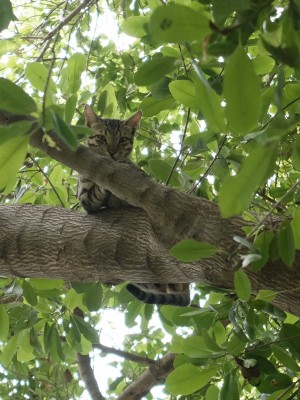 The other main activity was building the nilgai proof fence around the vegetable patch. One night 18 nilgai were spotted running through the rice. Another less destructive visitor was this wildcat detected by the dogs in a raini tree near the house.
The other main activity was building the nilgai proof fence around the vegetable patch. One night 18 nilgai were spotted running through the rice. Another less destructive visitor was this wildcat detected by the dogs in a raini tree near the house.
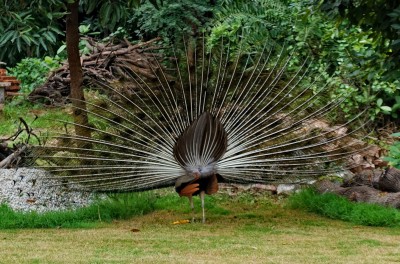 And here to finish with the backview of a dancing peacock. One usually sees the front and is unaware of the striking infrastructure holding everything up.
And here to finish with the backview of a dancing peacock. One usually sees the front and is unaware of the striking infrastructure holding everything up.
On the Farm - July ’18
We started the month with a dry farm with little greenery and by the end the monsoon had transformed our surroundings.
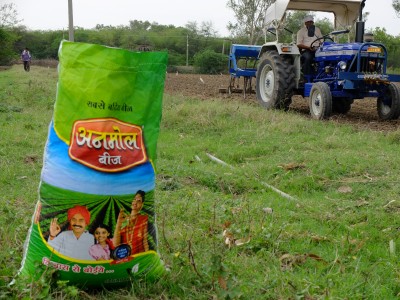 We sowed some soyabean at the beginning of the month for nitrogen fixing. The picture on the sack shows happy farmers in front of neat weedless rows. This is absolutely impossible without heavy use of herbicides and hoeing between rows.
We sowed some soyabean at the beginning of the month for nitrogen fixing. The picture on the sack shows happy farmers in front of neat weedless rows. This is absolutely impossible without heavy use of herbicides and hoeing between rows.
After the soyabean it was time to prepare the fields for rice. Here the tractor is doing what I call guddling and churning up the soil in a flooded field. Once the mud was ready the women transplanted the rice plants keeping going even through the monsoon rain.
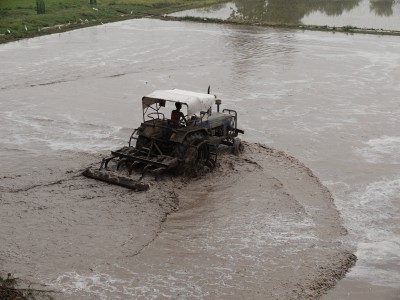
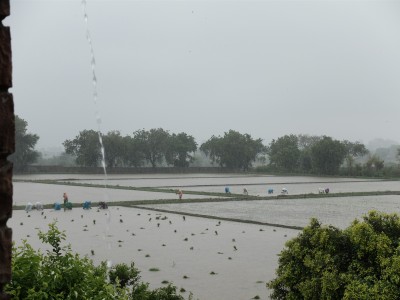
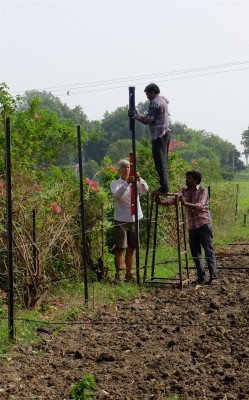 We then started constructing a nilgai proof fence around the vegetable patch using a post driver to pound angle iron posts into the ground; this proved very effective.
We then started constructing a nilgai proof fence around the vegetable patch using a post driver to pound angle iron posts into the ground; this proved very effective.
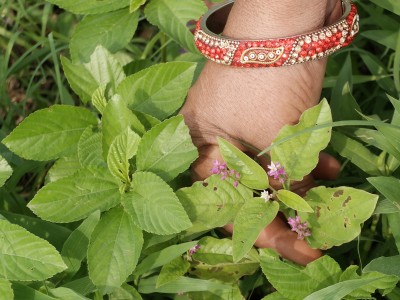 As soon as the first rain comes the weeds spring up. At first glance all these weeds look the same, but the leaf being held is called khunijra and has a smooth edge to each leaf. The plant to the left has a serrated edge to the leaf and is locally called rajaan. Both of these plants make a tasty vegetable dish once well boiled. They are always picked and cooked separately despite looking so similar.
As soon as the first rain comes the weeds spring up. At first glance all these weeds look the same, but the leaf being held is called khunijra and has a smooth edge to each leaf. The plant to the left has a serrated edge to the leaf and is locally called rajaan. Both of these plants make a tasty vegetable dish once well boiled. They are always picked and cooked separately despite looking so similar.
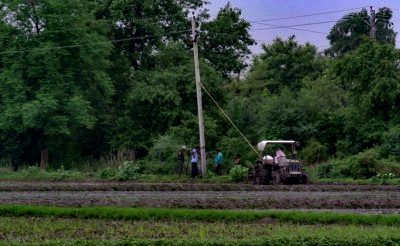 It was also the month when one of the electricity poles on the farm began to lean dangerously when the rains softened the soil. It had been leaning for some time, but in the rains this month the lean became pronounced. This was straightened on 20th July with the help of a tractor under the supervision of the electricity company linesman after a "shutdown" to render the whole operation safe. Large stones were driven into sides of the pole with a crow bar to prop it upright.
It was also the month when one of the electricity poles on the farm began to lean dangerously when the rains softened the soil. It had been leaning for some time, but in the rains this month the lean became pronounced. This was straightened on 20th July with the help of a tractor under the supervision of the electricity company linesman after a "shutdown" to render the whole operation safe. Large stones were driven into sides of the pole with a crow bar to prop it upright.
On the Farm - June ’18
June was unusually hot and dry with no real pre-monsoon shower until the 29th when 9 cms. fell in three hours ending the parched summer.
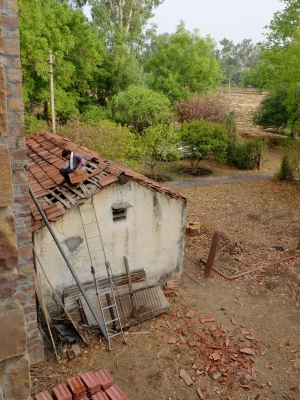 The month was spent repairing roofs, cleaning drains, cutting brush and giving the lawn its annual cut: it is called carpet grass and barely grows; we cut it back to the roots in June and it sprouts green again in the rains. These tiles on the garage roof were broken by wood apples falling on them, but since the wood apple or kaint tree is no longer there we shouldn’t have that problem again.
The month was spent repairing roofs, cleaning drains, cutting brush and giving the lawn its annual cut: it is called carpet grass and barely grows; we cut it back to the roots in June and it sprouts green again in the rains. These tiles on the garage roof were broken by wood apples falling on them, but since the wood apple or kaint tree is no longer there we shouldn’t have that problem again.
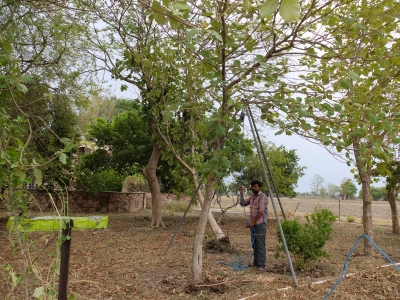 Some small 'typhoons' resulted in this teak tree being blown over. We tried pulling it upright using the Gypsy four-wheel drive, but in the end had to resort to drastic surgery and lopped the top before re-embedding and supporting it. We’ll see if it survives.
Some small 'typhoons' resulted in this teak tree being blown over. We tried pulling it upright using the Gypsy four-wheel drive, but in the end had to resort to drastic surgery and lopped the top before re-embedding and supporting it. We’ll see if it survives.
On 21st Kota made the Guiness Book of Records for gathering over 100,000 people together to do yoga on World Yoga Day led by Baba Ramdev and the Chief Minister of Rajasthan, Vasundra Raje. Our maid Sugna was there having never done yoga in her life as two free buses left the village at 5am to take them to the event site. She sat on a matting provided in her sari and copied the movements from the nearest TV screen. She got back to the village at 9am and walked straight back to the farm to do a day’s work.
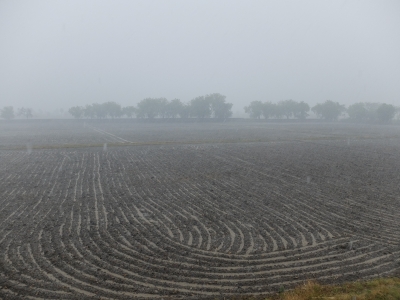 Dhaincha, a green manuring crop was broadcast on 28th June and on the 29th we had heavy rain. The rain accentuated the furrows like the whorls on the earth’s finger prints.
Dhaincha, a green manuring crop was broadcast on 28th June and on the 29th we had heavy rain. The rain accentuated the furrows like the whorls on the earth’s finger prints.
On the Farm - May ’18
As expected, May was an extremely hot dry month with temperatures reaching 47oC and only a few drops of rain. Dust storms, but nothing like the violent storms further north in Rajasthan and U.P., swept through our farm shaking trees dramatically. We altered the mens’ hours so they worked from 7.00-10.30 and then 4.00-7.00 so they weren’t working during the hottest part of the day. Other labourers were not so lucky and toiled slowly in the heat.
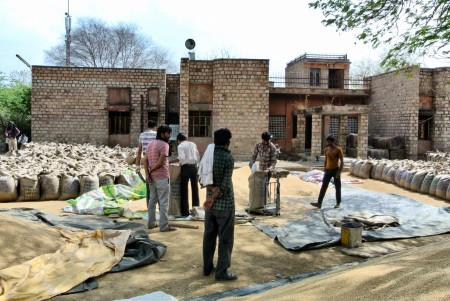 We sold two trolley loads of wheat to the Government on May 4th. They paid a minimum support price of Rs.1735 per 100kgs. which was more than on the open market. The purchasing centre was a former oil processing facility on the other side of town 18.5 kms. away, so haulage costs were higher. There were no crowds of sellers, but they ran out of sacks so our man, in red and white striped T-shirt had to stay there overnight guarding our pile of wheat. Four young men laboured all day filling 50 kg. sacks and weighing them. The farmers paid them Rs.5 per sack in cash. The Government money was due by direct transfer and took 21 days. This is a massive change towards acccountability. Farmers pay no tax below a certain threshold and all transactions used to be in cash.
We sold two trolley loads of wheat to the Government on May 4th. They paid a minimum support price of Rs.1735 per 100kgs. which was more than on the open market. The purchasing centre was a former oil processing facility on the other side of town 18.5 kms. away, so haulage costs were higher. There were no crowds of sellers, but they ran out of sacks so our man, in red and white striped T-shirt had to stay there overnight guarding our pile of wheat. Four young men laboured all day filling 50 kg. sacks and weighing them. The farmers paid them Rs.5 per sack in cash. The Government money was due by direct transfer and took 21 days. This is a massive change towards acccountability. Farmers pay no tax below a certain threshold and all transactions used to be in cash.
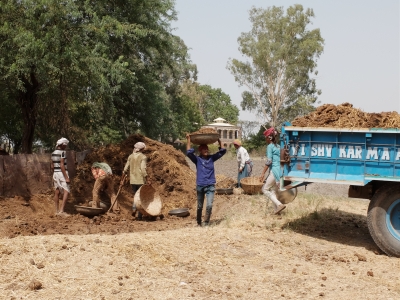 Towards the end of the month we hired extra labour to empty the gobar (cow dung) pit and spread it on the fields. This hadn’t been done for two years and the khad (manure) at the bottom was well rotted and went on the vegetable patch. The next challenge is to build a nilgai proof fence around it before sowing everything.
Towards the end of the month we hired extra labour to empty the gobar (cow dung) pit and spread it on the fields. This hadn’t been done for two years and the khad (manure) at the bottom was well rotted and went on the vegetable patch. The next challenge is to build a nilgai proof fence around it before sowing everything.
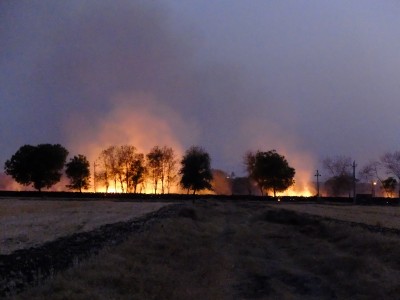 And a dramatic, but dodgy, photo to end on of our neighbour burning his stubble so he can grow rice. When you flood the fields the remaining wheat straw in the fields floats and is a nuisance. Mustard stubble was ploughed in but where wheat was grown and rice is to be sown, our short stubble was also burnt. This was the compromise: shorter stubbble so less pollution when burnt. It was noticeable this year that there was far less stubble burning and most farmers that did resort to it, had taken the trouble to get their wheat stalks cut first (see last month’s blog).
And a dramatic, but dodgy, photo to end on of our neighbour burning his stubble so he can grow rice. When you flood the fields the remaining wheat straw in the fields floats and is a nuisance. Mustard stubble was ploughed in but where wheat was grown and rice is to be sown, our short stubble was also burnt. This was the compromise: shorter stubbble so less pollution when burnt. It was noticeable this year that there was far less stubble burning and most farmers that did resort to it, had taken the trouble to get their wheat stalks cut first (see last month’s blog).
On the Farm - April ’18
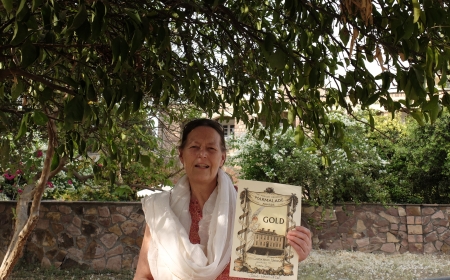 Some very surprising news was discovered in India in April after the publication of a food blog in livemint.com announcing that one Victoria Singh of Kota, Rajasthan had won the Gold Award for her marmalade in the Commonwealth Category at the World Original Marmalade Awards held at Dalemain in Cumbria, U.K. in March.
Some very surprising news was discovered in India in April after the publication of a food blog in livemint.com announcing that one Victoria Singh of Kota, Rajasthan had won the Gold Award for her marmalade in the Commonwealth Category at the World Original Marmalade Awards held at Dalemain in Cumbria, U.K. in March.
Here is a photo of me holding the certificate under the orange tree that bore the bitter oranges used in my 'Bitter Oranges and Ginger' marmalade. A lot of interest has been generated but I only made a few kgs. and there is none left. This coming winter I will have to make more but the market in India for a strong marmalade in very niche.
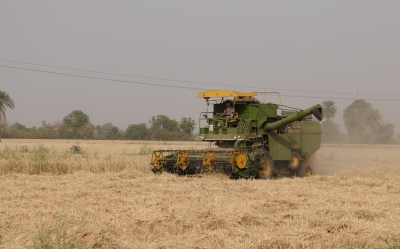
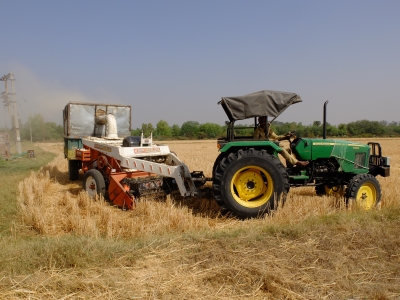
The main activities on the farm have been selling the mustard and combine-harvesting the wheat.
Here is the combine. It leaves a long stalk in the soil and so this year we employed a straw making machine to go round each field cutting the tops and chopping them into small pieces before blowing them into a trolley. The owner charged Rs.1300 per trolley and he would sell it on for Rs.1800 for cattle feed so we gained Rs.500 a trolley and there was less stubble to burn in fields where we are going to be growing rice next. Win-win.
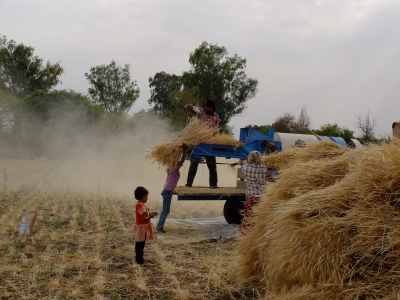 Our heritage wheat for home consumption was hand cut and threshed. The chaff is fine and silky and the cows enjoy it.
Our heritage wheat for home consumption was hand cut and threshed. The chaff is fine and silky and the cows enjoy it.
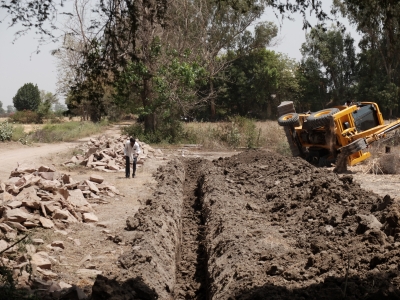 And to end, an action shot of a JCB just as it was tipping over. Quite suddenly it went past its tipping point and landed on its side, lying like a great wounded beast for a whole day before the owners could work out a way of pulling it upright with a strong chain, known locally as toe-chun (tow-chain), and another JCB. Fortuitously, there were no injuries to the driver or his passenger.
And to end, an action shot of a JCB just as it was tipping over. Quite suddenly it went past its tipping point and landed on its side, lying like a great wounded beast for a whole day before the owners could work out a way of pulling it upright with a strong chain, known locally as toe-chun (tow-chain), and another JCB. Fortuitously, there were no injuries to the driver or his passenger.
On the Farm - March ’18
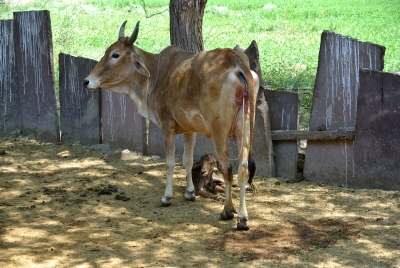 March was a very bountiful month with the birth of our third grandchild and three calves. The third of the three calves was named Kavyan, the middle name of our new grandchild Arthur. He was the first calf born to four-year old Ramini, the middle name of our eldest granchild Sophie who is also four.
March was a very bountiful month with the birth of our third grandchild and three calves. The third of the three calves was named Kavyan, the middle name of our new grandchild Arthur. He was the first calf born to four-year old Ramini, the middle name of our eldest granchild Sophie who is also four.
The mustard which had been cut in February was piled up on 9th March ready for threshing when a storm came and with it this beautiful rainbow. Very little rain, luckily, so threshing went ahead the next day and took two days to complete. The women worked until after sunset to finish off. By the end of the month the temperature had topped 40oC.
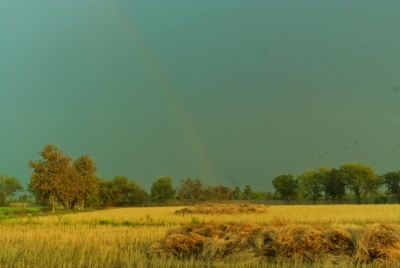
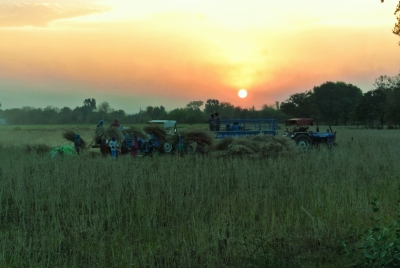
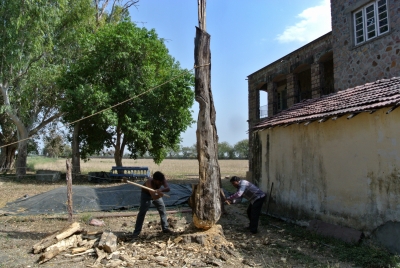 Three end of an era events happened this month. Our uncle Brigadier Nahar Singh on the neighbouring farm died on 13th March just four weeks after his wife - both will be sadly missed. This iconic kainth tree photographed during its final moments was probably older than any other tree around and pre-dated human settlement in this part of the jungle.
Three end of an era events happened this month. Our uncle Brigadier Nahar Singh on the neighbouring farm died on 13th March just four weeks after his wife - both will be sadly missed. This iconic kainth tree photographed during its final moments was probably older than any other tree around and pre-dated human settlement in this part of the jungle.
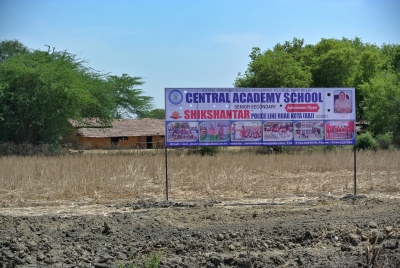
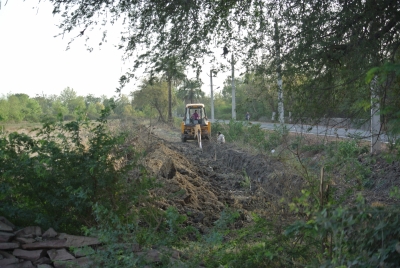
And the field to the right of the gate now bears its new owner’s name and a boundary wall is being built. The remains of mustard, the last agricultural crop to be grown there can be seen behind the banner. More of India’s irrigated best farmland disappears under concrete. End of an era for this field as well.
On the Farm - February ’18
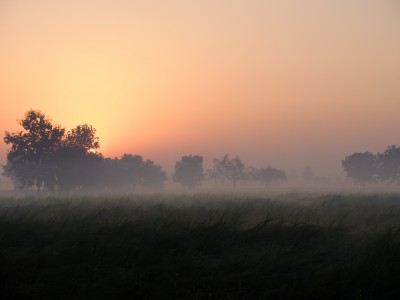 February started with beautiful misty sunrises and night temperatures of 9oC.
February started with beautiful misty sunrises and night temperatures of 9oC.
The main focus of the month was to protect the green and tender wheat from the nightly visits of a herd of nilgai. The 2200 - 2400 midnight patrol was not good enough and they returned and grazed peacefully until sunrise. An extra young man was employed to patrol so we had three duties: 2200-2400, 2300-0100 and 2400-0200. After 0200 hrs. Vijay kept checking with a powerful torch leading to very erratic sleep patterns. The men were given time off during the day in lieu. Watering was the other main activity.
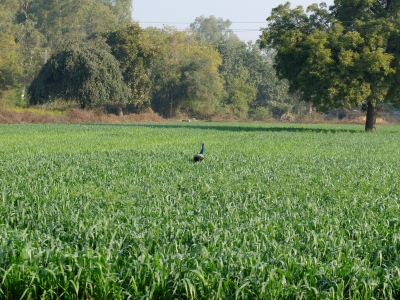 This photo was taken on 1st February. Not only was the wheat feeding nilgai but peacocks, pigs and monkeys too!
This photo was taken on 1st February. Not only was the wheat feeding nilgai but peacocks, pigs and monkeys too!
During the month the mustard ripened and a team of women came to cut it. The imported American hybrid plants patented by DuPont were not intended to be harvested by sickles and were so dense and tough that the women asked for the rate to be increased from Rs.825 per bigha to Rs.1000. The yield was good, however. These are not terminator seeds and will sprout but we are not allowed to keep the seed and plant it next year.
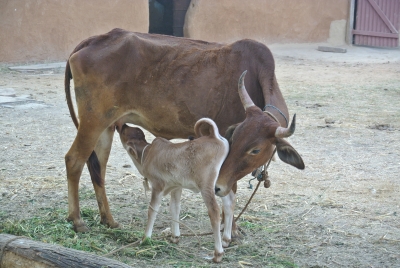 During the month two calves were born and here is Sheoji born on 13th February to Charlotte who is seen here nudging her son into a good sucking position.
During the month two calves were born and here is Sheoji born on 13th February to Charlotte who is seen here nudging her son into a good sucking position.
On the Farm - January ’18
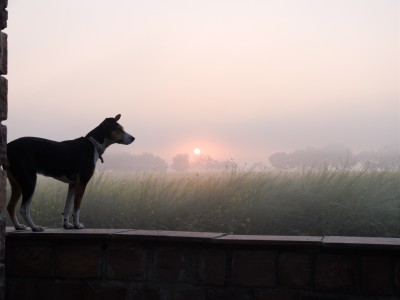 January is a very beautiful month with the sunrise dispersing early mist over the fluorescent yellow flowering mustard fields. Unfortunately, if the wind is from the S.E. the mist traps the smell from the brick kilns and it can be so unpleasant that we retreat indoors for breakfast.
January is a very beautiful month with the sunrise dispersing early mist over the fluorescent yellow flowering mustard fields. Unfortunately, if the wind is from the S.E. the mist traps the smell from the brick kilns and it can be so unpleasant that we retreat indoors for breakfast.
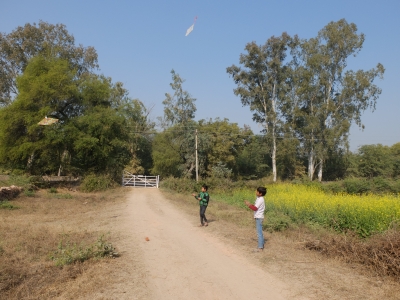 14th January is Makkar Sankranti known as kite flying day over much of northern India and it marks the start of the northward journey of the sun in the solar zodiacal calendar or specifically the day on which the sun enters the zodiac Capricorn/Makkar. Children for weeks beforehand spend their time kite flying and kite fighting. Some of the string (manja) leading to the kite is covered in powdered glass so it can cut the opponents kite string better. It also wraps itself around childrens necks and people have been garotted while driving their scooters and motorbikes.
14th January is Makkar Sankranti known as kite flying day over much of northern India and it marks the start of the northward journey of the sun in the solar zodiacal calendar or specifically the day on which the sun enters the zodiac Capricorn/Makkar. Children for weeks beforehand spend their time kite flying and kite fighting. Some of the string (manja) leading to the kite is covered in powdered glass so it can cut the opponents kite string better. It also wraps itself around childrens necks and people have been garotted while driving their scooters and motorbikes.
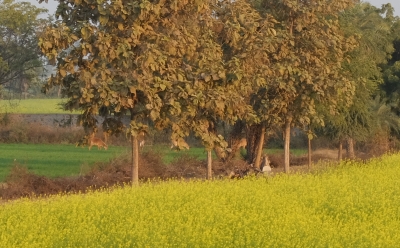 Apart from watering the main job is protecting the young wheat from the monkeys, pigs and a herd of nilgai or blue bull. The night rota for crop protection continued this month, but one morning 15 nilgai were seen exiting the farm at 6am. They know to put in an appearance before midnight to be chased away, but it seems that the majority of them enter the farm after the duty rota is finished and when no torches or room lights can be seen. Here five nilgai are moving slowly off having been chased out of the tall mustard where they were hiding by day.
Apart from watering the main job is protecting the young wheat from the monkeys, pigs and a herd of nilgai or blue bull. The night rota for crop protection continued this month, but one morning 15 nilgai were seen exiting the farm at 6am. They know to put in an appearance before midnight to be chased away, but it seems that the majority of them enter the farm after the duty rota is finished and when no torches or room lights can be seen. Here five nilgai are moving slowly off having been chased out of the tall mustard where they were hiding by day.

